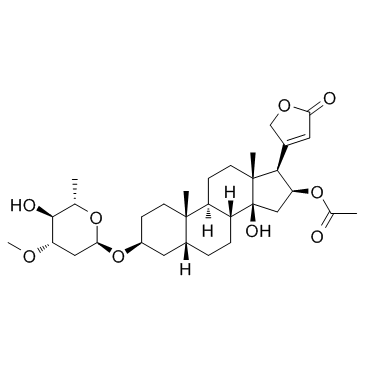In vitro study of the effectiveness of three commercial adsorbents for binding oleander toxins.
Asheesh K Tiwary, Robert H Poppenga, Birgit Puschner
文献索引:Clin. Toxicol. (Phila.) 47(3) , 213-8, (2009)
全文:HTML全文
摘要
Oleander (Nerium oleander) poisoning is a common problem found in many parts of the world. The oleander toxicity is due to oleandrin and its aglycone metabolite oleandrigenin. Activated charcoal is a useful gastrointestinal decontamination agent that limits the absorption of ingested toxins. A relatively new clay product, Bio-Sponge, containing di-tri-octahedral smectite as the active ingredient, is also recommended for adsorbing bacterial toxins in the gastrointestinal tract. Bio-Sponge has been used to prevent gastrointestinal absorption of oleander toxins in livestock but the efficacy of activated charcoal and Bio-Sponge for adsorbing oleandrin and oleandrigenin has not yet been studied.An in vitro experiment to compare the efficacy of three commercially available adsorbents was performed. The adsorbents include Bio-Sponge, ToxiBan granules, and a generic grade activated charcoal.ToxiBan granules have the highest adsorptive capacity, followed by the generic grade activated charcoal, and finally, Bio-Sponge.Bio-Sponge did not adsorb oleandrin and oleandrigenin at concentrations that are expected to be present in the gastrointestinal tract of poisoned animals.On the basis of this in vitro study, products containing activated charcoal are more effective for binding oleander toxins and providing gastrointestinal decontamination than products containing di-tri-octahedral smectite. However, the ability of these adsorbents to alter the clinical outcome in oleander-poisoned animals or humans is yet to be evaluated.
相关化合物
| 结构式 | 名称/CAS号 | 分子式 | 全部文献 |
|---|---|---|---|
 |
欧夹竹桃苷
CAS:465-16-7 |
C32H48O9 |
|
Rapid detection of convallatoxin using five digoxin immunoas...
2014-08-01 [Clin. Toxicol. (Phila.) 52(7) , 659-63, (2014)] |
|
PBI-05204, a supercritical CO₂ extract of Nerium oleander, i...
2015-04-01 [Invest. New Drugs 33(2) , 271-9, (2015)] |
|
BDNF mediates neuroprotection against oxygen-glucose depriva...
2014-01-15 [J. Neurosci. 34(3) , 963-8, (2014)] |
|
Cytotoxic effects of cardiac glycosides in colon cancer cell...
2009-11-01 [J. Nat. Prod. 72 , 1969-74, (2009)] |
|
Unexpectedly dangerous escargot stew: oleandrin poisoning th...
2006-01-01 [J. Anal. Toxicol. 30(9) , 683-6, (2006)] |